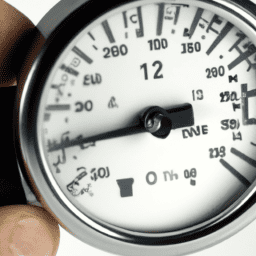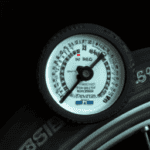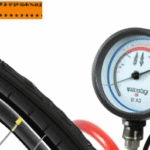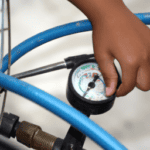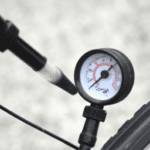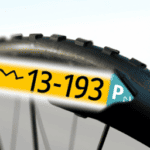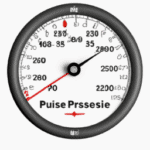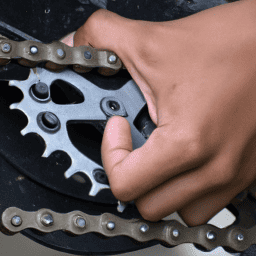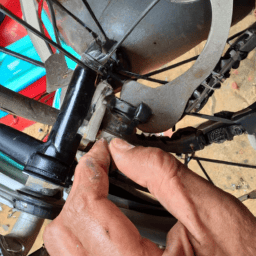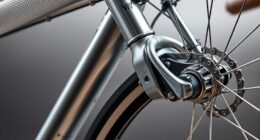You could be wondering, ‘Why is it necessary to know the precise psi my bike tire requires? Can’t I simply estimate by looking?’
But the truth is, tire pressure is crucial to the performance and safety of your bike. Riding with too low or too high pressure can lead to a host of problems, from decreased efficiency to a higher risk of punctures and accidents.
So, let’s get into the nitty-gritty of tire pressure. The ideal psi (pounds per square inch) for your bicycle tire depends on a few factors, such as your weight, the type of bike you have, and the terrain you’ll be riding on.
In this article, we’ll cover how to determine the appropriate tire pressure for your bike, how to check it using a pressure gauge, and how to adjust it as needed for optimal performance. By the end, you’ll have the knowledge to ensure that your tires are properly inflated and ready to take you on your next adventure.
Key Takeaways
- The ideal psi for a bike tire depends on various factors, including the rider’s weight, type of bike, and riding conditions.
- Regular monitoring and maintenance of tire pressure is crucial for bike performance, handling, and safety.
- The recommended pressure range listed on the tire is a maximum, and the optimal psi may be lower than that.
- Under-inflation and over-inflation can both pose risks to bike safety and tire longevity, making it necessary to use a pressure gauge for accuracy.
Understand the Importance of Tire Pressure
You gotta understand that tire pressure is super important for your ride, so make sure you check it regularly.
Maintaining the right tire pressure ensures your safety and efficiency while riding. If your tire pressure is too low, it can cause your bike to handle poorly and make it harder to pedal. On the other hand, if the pressure is too high, you run the risk of a blowout or losing control of your bike.
It’s also important to note that temperature can impact tire pressure. As temperature rises, tire pressure increases, and as it drops, tire pressure decreases. This is because air expands when heated and contracts when cooled.
So, if you’ve checked your tire pressure on a cold morning and then ride in the heat of the day, you may need to adjust the pressure accordingly.
Understanding the importance of tire pressure and how temperature can affect it will help you maintain a safe and efficient ride.
Now, let’s move on to determining the appropriate tire pressure for your bike.
Determine the Appropriate Tire Pressure
Feeling confident about your ride requires knowing the appropriate tire pressure for your bicycle. Factors affecting tire pressure include the type of tire, the weight of the cyclist, and the terrain on which you’ll be riding.
The consequences of incorrect pressure can range from a bumpy ride to decreased control, and even the risk of a blowout. To determine the ideal tire pressure for your bike, check the sidewall of the tire for the recommended pressure range. This range is often given in pounds per square inch (PSI), and will vary depending on the specific tire.
It’s important to note that the pressure range listed on the tire is a maximum, and the optimal pressure may be lower. Experiment with different pressures until you find what feels best for your riding style and the terrain you encounter.
Remember to regularly check and adjust your tire pressure as needed to ensure a smooth and safe ride. Transitioning into the subsequent section, using a pressure gauge to check tire pressure can help ensure accuracy and consistency in maintaining the appropriate pressure for your bike.
Use a Pressure Gauge to Check Tire Pressure
Using a pressure gauge is a reliable way to determine the appropriate air pressure for your bike’s tires, as demonstrated by Tom who noticed improved speed and control after consistently using a gauge to maintain his tire pressure.
However, it’s important to use proper technique when checking tire pressure. First, make sure the tire is fully deflated before taking the reading. Next, attach the gauge to the valve stem and press down firmly to get an accurate reading.
Common mistakes include not properly attaching the gauge, not holding it firmly enough, or not taking the reading when the tire is fully deflated.
There are different types of pressure gauges available, including digital and analog gauges. Digital gauges are generally more accurate and easier to read, but they can be more expensive and require batteries. Analog gauges are more affordable and do not require batteries, but they can be less precise and harder to read.
Regardless of the type of gauge used, it’s important to check tire pressure regularly and adjust as needed for optimal performance and safety.
Adjust Tire Pressure as Needed
Maintaining proper tire pressure is essential for a smooth and safe ride, so it’s important to check and adjust as necessary. Proper inflation techniques are crucial to ensure that your bike tire is inflated to the recommended PSI level.
Under-inflation can cause the tire to wear out faster and increase the risk of pinch flats, while over-inflation can lead to a harsh ride and increase the risk of a blowout. To adjust tire pressure, use a tire pump with a pressure gauge to inflate or deflate the tire as necessary.
Be sure to match the PSI level to the recommended range indicated on the tire sidewall. It’s also important to regularly monitor tire pressure for optimal performance. This can be done before each ride or at least once a week to ensure that your bike is ready for your next adventure.
Regularly Monitor Tire Pressure for Optimal Performance
It’s crucial to keep a close eye on your bike’s tire pressure for optimal performance, ensuring a smooth and safe ride every time. Regularly monitoring your tire pressure can also help extend the life of your tires, prevent flats, and improve overall bike handling.
Here are some factors affecting tire pressure and the importance of tire tread that you should keep in mind:
-
Factors Affecting Tire Pressure: The ideal tire pressure for your bike can vary depending on the type of bike and tire you have, as well as your weight and the terrain you’ll be riding on. Other factors that can affect your tire pressure include temperature changes, altitude, and the type of valve stem on your tire. It’s important to check your tire pressure before every ride and adjust it as needed to ensure optimal performance.
-
Importance of Tire Tread: Your tire’s tread plays a crucial role in maintaining traction and preventing slips and skids while riding. Worn-down tread can reduce your bike’s handling and increase your risk of accidents. To ensure optimal tire performance, inspect your tire tread regularly and replace your tires as needed to maintain a safe and smooth ride.
By regularly monitoring your tire pressure and inspecting your tire tread, you can ensure optimal bike performance and safety. Remember to check your tire pressure before every ride and adjust it as needed, and inspect your tire tread regularly to prevent slips and skids. These simple steps can help extend the life of your tires and keep you riding smoothly and safely.
Frequently Asked Questions
What happens if I overinflate my bike tires?
Overinflating your bike tires can lead to a higher risk of tire blowouts, which can be dangerous while riding. Make sure to check for bulges or cracks in the tire walls regularly to avoid this issue.
Can I use any pressure gauge to check my bike tire pressure?
To ensure accuracy, it is recommended to use a pressure gauge designed for bicycles. Different types of gauges, such as dial and digital, exist. Be sure to follow the manufacturer’s instructions for best results.
How often should I replace my bike tires?
So, you want to know when to replace your bike tires? Well, it all depends on factors such as usage, terrain, and tire quality. The best time to replace them is when the tread wears down to a dangerous level.
Does the rider’s weight affect the recommended tire pressure?
The rider’s weight affects tire pressure accuracy. Different tire types also require different pressures. Consult the tire manufacturer’s specifications for the recommended pressure range, and adjust accordingly for your weight and tire type.
Is it safe to ride a bike with low tire pressure?
Riding a bike with low tire pressure increases the risks of flats, reduced handling, and loss of control. Always ensure your tires are inflated to the recommended levels for your weight and riding conditions, which can vary between tire types and brands.
Conclusion
Congratulations! You now know how important it is to maintain the right tire pressure for your bicycle. By following the steps outlined in this article, you can determine the appropriate tire pressure, use a pressure gauge to check it regularly, and make necessary adjustments for optimal performance.
But what if you neglect your tire pressure? Well, let’s just say it won’t be pretty. Your ride will be bumpy, your control will be compromised, and your tires may even wear out prematurely.
So, take the time to check your tire pressure regularly and keep it at the recommended level. Your bike (and your behind) will thank you for it!
